#Emperor of Austria
Explore tagged Tumblr posts
Text

Emperor Franz I of Austria. By Füger.
#heinrich friedrich füger#kaisertum österreich#kaiser#erzherzog#franz I.#haus habsburg lothringen#emperor of austria#house of habsburg lorraine#art#portrait#emperor#museo del prado
20 notes
·
View notes
Text

Francis I, Emperor of Austria (1768-1835)
Artist: Sir Thomas Lawrence (English, 1769-1830)
Date: 1818-1819
Medium: Oil on canvas
Collection: Royal Collection Trust, London, United Kingdom
Francis I, Holy Roman Emperor
Francis I (Francis Stephen; French: François Étienne; German: Franz Stefan; Italian: Francesco Stefano; 8 December 1708 – 18 August 1765) was Holy Roman Emperor from 1745 to 1765, Archduke of Austria from 1740 to 1765, Duke of Lorraine and Bar from 1729 to 1737, and Grand Duke of Tuscany from 1737 to 1765. He became the ruler of the Holy Roman Empire, Austria, and Tuscany through his marriage to his second cousin Maria Theresa of Austria, daughter of Emperor Charles VI. Francis was the last non-Habsburg monarch of the Empire. The couple were the founders of the Habsburg-Lorraine dynasty, and their marriage produced sixteen children
#portrait#full length#francis i#emperor of austria#holy roman empire#painting#oil on canvas#fine art#oil painting#artwork#austrian history#chair#costume#hat#red curtains#table#house of lorraine#english culture#english art#sir thomas lawrence#english painter#19th century painting#royal collection trust
16 notes
·
View notes
Text

Franz Joseph I, Emperor of Austria. Unknown artist.
#kaisertum österreich#haus habsburg lothringen#kaiser#Franz Joseph I#Emperor of Austria#austrian empire#magyar királyság#königreich ungarn#kingdom of hungary#house of habsburg lorraine#Österreichisch Ungarische Monarchie#Osztrák Magyar Monarchia#Osztrák-Magyar Monarchia#Österreichisch-Ungarische Monarchie#köngireich böhmen#kingdom of bohemia#royalty#pornstache
3 notes
·
View notes
Text

Blessed Karl of Austria praying.
#my post#uniform#army#emperor#king#emperor of austria#king of hungry#hapsburg#hapsburgs#von hapsburg#charles i#karl i#austro-hungarian empire#austria-hungry#blessed charles of austria#catholic#roman catholic#blessed karl of austria#monarchy
2 notes
·
View notes
Text


Mass Grave of Roman Soldiers Discovered in Austria
The renovation of a football pitch in Austria’s capital has led to the discovery of a Roman mass grave housing the remains of more than a hundred soldiers who died in combat.
The construction company working on the sports field in the district of Simmering in Vienna found a large number of human remains at the site in late October, according to the Vienna Department of Urban Archaeology, part of the Wien Museum.
The remains of at least 129 individuals were uncovered during excavations by archaeologists and anthropologists from the museum and archaeological excavation company Novetus, the museum said in a press release Wednesday.
However, the total number of individuals is estimated to be more than 150, as the earlier construction works had displaced a large number of dislocated bones in the 16-foot-long pit.
The skeletal finds suggest “a hasty covering of the dead with earth,” as the individuals were not buried in an orderly fashion, but with their limbs intertwined with each other’s and with many lying on their stomachs or sides, the museum said.
‘Catastrophic’ military operation
After the skeletons were cleaned up and examined, researchers found that they were all male, and most were more than 1.7 meters tall (more than 5 feet 7 inches) and between the ages of 20 and 30 when they died.
Their dental health was generally good, with few signs of infection, but every individual analyzed bore injuries sustained at or near their time of death.

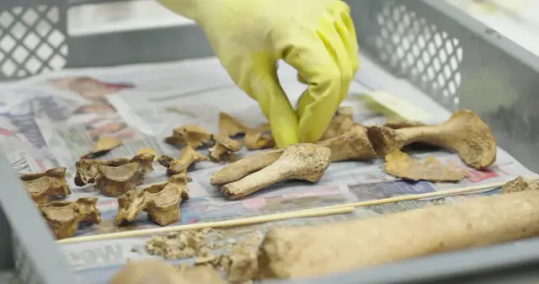
The variety of wounds, which were mainly found in the skull, pelvis and torso, and made by weapons including spears, daggers, swords and iron bolts, suggests they were sustained during battle rather than the result of execution – the punishment for military cowardice, the museum said.
“As the remains are purely male, it can be ruled out that the site of discovery was not connected with a military hospital or similar or that an epidemic was the cause of death. The injuries to the bones are clearly the result of combat,” it added.
The bones were dated to approximately 80 to 230 AD.
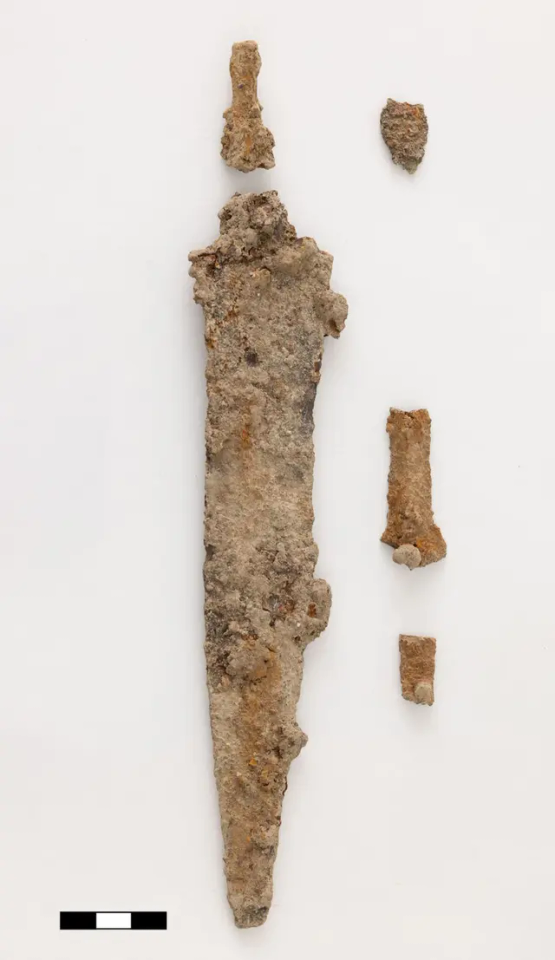
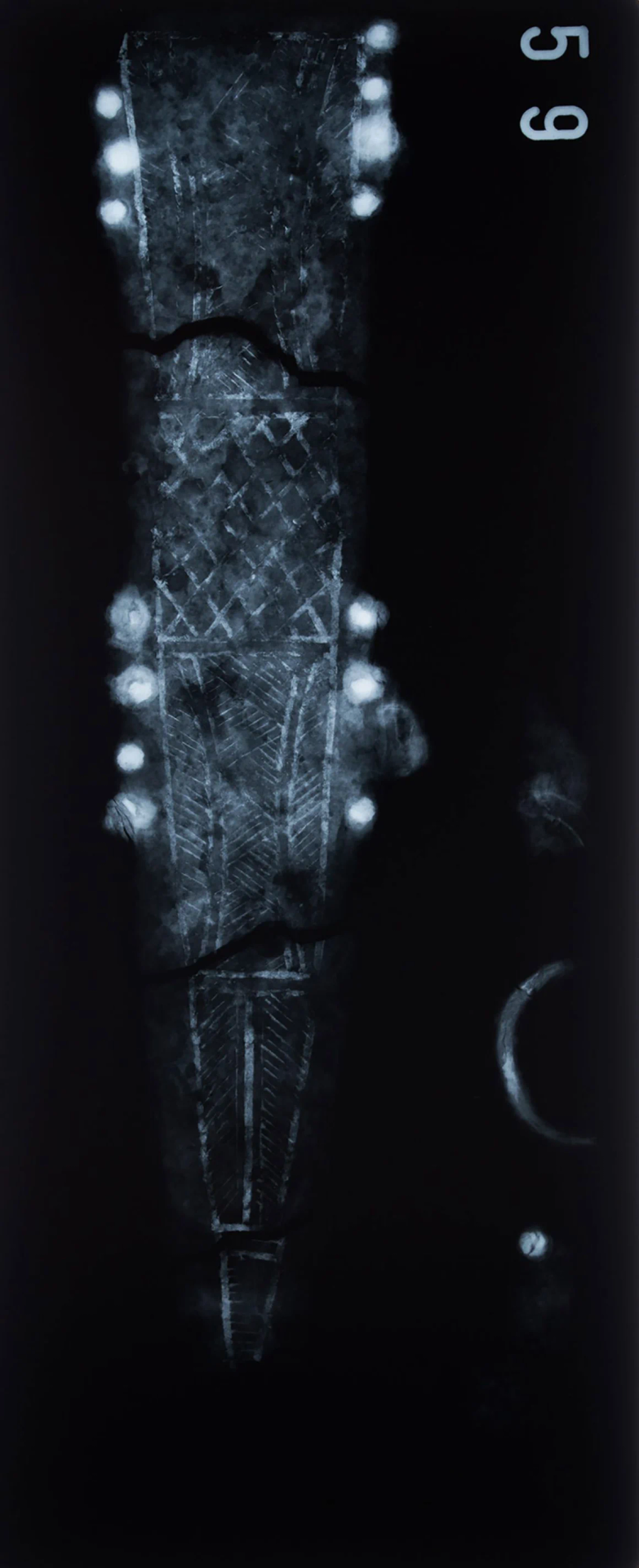
The men were probably robbed of their weapons, since only a small number of objects were found alongside them, according to the release.
Archaeologists uncovered two iron spearheads, one of which was found lodged in a hip bone.
Numerous hobnails were discovered near the feet of one individual. These nails would have studded the underside of leather Roman military shoes, the museum said.
An X-ray of the scabbard of a rusted and corroded iron dagger revealed typical Roman decorations of inlays of silver wire. This was dated to between the mid-1st century and early 2nd century AD.
There were also several pieces of scale armor, which became customary around 100 AD, the museum said. However, they were unusual in having more square-shaped features than round, it added.
A cheek piece from a Roman helmet was found to be from a type that became customary from the middle of the 1st century.
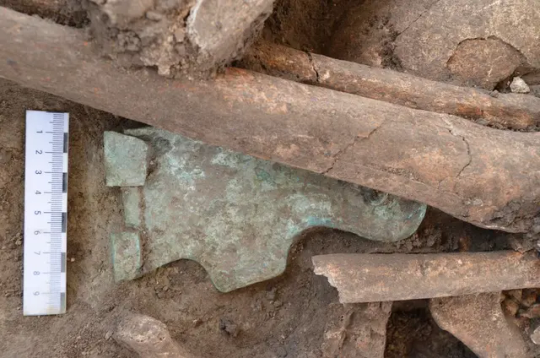
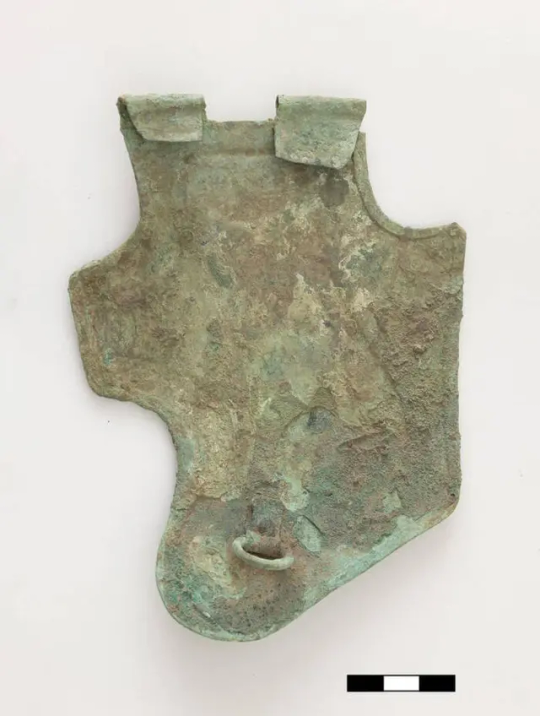


“We are blown away by this find. It is a genuine game-changer,” Kristina Adler-Wölfl, head of the Vienna Department of Urban Archaeology, said Friday, adding that this is “a once-in-a-lifetime discovery” for the museum’s archaeologists.
“There is archaeological evidence of Roman battlefields in Europe, but none from the 1st/2nd century CE with fully preserved skeletons,” she said.
Around 100 AD, ritualized cremation burials were common in the Roman-governed parts of Europe, with whole-body burials “an absolute exception,” according to the museum. “Finds of Roman skeletons from this period are therefore extremely rare,” it said.
“The undignified nature of the burial site along with the deadly wounds found on each individual suggests a catastrophic military confrontation, possibly followed by a hasty retreat,” Adler-Wölfl added.



Battle at the dawn of urban Vienna
Historical records show that in the late 1st century, during the reign of the emperor Domitian, costly battles took place on the Roman Empire’s northern Danube border between the Romans and Germanic tribes.
“This is the first time we have material evidence of the Germanic wars” fought by Domitian between 86 and 96 AD, Adler-Wölfl said. “Before the find, we knew about these conflicts only through some written sources.”
“Our preliminary investigation suggests with near certainty that the mass grave is the result of such a Roman-Germanic battle, one that likely took place in or around 92 CE,” she added.
The destruction of an entire legion is included in reports of disastrous defeats, which later led to the extension of the fortification line known as the Danube Limes under the emperor Trajan, according to the museum.
The Roman expansion of the town of Vindobona, which later became Vienna, “from a small military site to a full-scale legionary fortress occurred in that context,” said Adler-Wölfl.
“This would place the mass grave in immediate conjunction with the beginning of urban life in present-day Vienna,” she added.
The initial investigation by the team in Vienna will form part of a larger international research project, the museum said. This will include DNA analysis, to shed light on the lives of the soldiers and their living conditions.



#Mass Grave of Roman Soldiers Discovered in Austria#Simmering in Vienna Austria#roman battelfield#mass grave#roman weapons#ancient artifacts#archeology#history#history news#ancient history#ancient culture#ancient civilizations#roman history#roman empire#roman emperor
101 notes
·
View notes
Text



Devrim Lingnau and Philip Froissant as Empress Elisabeth and Emperor Franz Joseph in the second season of The Empress (2022).
#The Empress#The Empress (2022)#Die Kaiserin#costume drama#historical drama#period drama#devrim lingnau#Philip Froissant#Elisabeth in Bavaria#elisabeth of austria hungary#elisabeth of austria#Emperor Franz Joseph#Franz Joseph of Austria#german tv#german series#Netflix
109 notes
·
View notes
Text



HI HI HI I WENT TO COMIC CON UHH I met SOOO MANY cool people aauughhwhh I included all the autographs I got! Some CRAZY people in there... Anyways so I drew this as a gift to Chuck Huber, my favorite voice actor! My favorite role of his is Austria from Hetalia but of COURSE I adore Hiei, 17, Pilaf, and many others too...
He not only signed this print (and my nendoroid and 1 other print AND gave me a free metallic one because he said I was awesome)(!?!?!!) BUT he asked for my info so he can COMMISSION ME!?!? which is. erm. insane... I'll update y'all if anything ever comes of that... But um yes he loved the drawing (yay) and so did the other Dragon Ball voice actors (my mom wanted to show it to everyone💀) AND ANDROID 18 AND KRILLIN'S VOICE ACTORS ALSO SAID THEY'D BUY MY ART AND I WAS SO FLOORED WHERE THE ACTUAL HELL AM I.
But probably the highlight was meeting Blueys parents, I won't go into detail but I cried like CRAZY and I got awesome hugs they were the nicest people ever (shocker)😭 And I met Jared Padalecki and Elijah Wood and Sean Austin (literally the main characters from THE LORD OF THE RINGS and Supernatural!?) and holy gyatt guys this was far and away my best con. Dameon Clarke was also there again but he literally lives in my city (lmfao) so I didn't bug him this time since I've met him a lot already :]
OH YEAH AND THE SECOND DRAWING HERE IS TOTALLY UNRELATED I JUST THREW IT IN HERE BECAUSE AUSTRIA LMAO
#my art#austria#aph#aph hetalia#hetalia#austria aph#austria hetalia#roderich edelstein#android 17#hiei#hiei jaganshi#yyh#yu yu hakusho#hetalia axis powers#hetalia fanart#emperor pilaf#dbz#dragon ball fanart#chuck huber#comic con
46 notes
·
View notes
Text
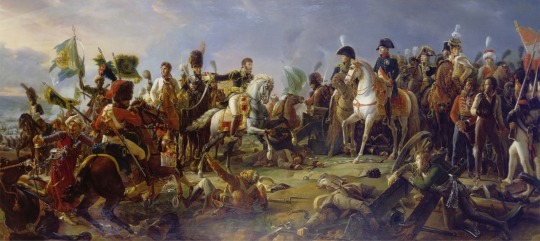
The Battle of Austerlitz, 2nd December 1805 by François Gérard
#battle of austerlitz#art#françois gérard#napoleonic wars#napoleonic#napoleon bonaparte#france#emperor#napoléon#napoleon#emperors#empire#empires#russia#austria#habsburg#holy roman empire#french empire#russian empire#austrian empire#europe#european#history#bonaparte#napoléon bonaparte#french#austrian#russian#battle
157 notes
·
View notes
Text




Movies: Sissi (1955); Sissi - Die junge Kaiserin (1956) & Sissi - Schicksalsjahre einer Kaiserin (1957) | dir. by Ernst Marischka
Sissi #classiccinema #romyschneider
Watch this video on Youtube: https://www.youtube.com/watch?v=-N4x_LbBx9A
#Sissi#1955#Sissi - Die junge Kaiserin#Sissi - The Young Empress#Sissi Emperatriz#1956#Sissi - Schicksalsjahre einer Kaiserin#Sissi - Fateful Years of an Empress#1957#movie#German film#German movie#youtube#shorts#short video#Romy Schneider#Isabel de Baviera#Empress Elisabeth of Austria#Karlheinz Böhm#Kaiser Franz Josef#Emperor Franz Joseph I of Austria
26 notes
·
View notes
Text

Double spiral staircase, an architectural and engineering marvel, is silently standing within a public building in old town of Graz in Strya, Austria.
Completed in 1438 under the guidance of Holy Roman Emperor Frederick III, the Burg of Graz was expanded by Frederick’s son, Emperor Maximilian, from 1494-1500.
When reopened, officials and civilians marvelled at "Doppelwendeltreppe," or “Double Spiral Staircase” that travelled two floors to top of tower.
This architectural masterpiece of 1499 has often been interpreted as a symbol of eternity.
Graz people call it "stairs of reconciliation."
If you go separate ways, you will at some point reunite.
Built by an unknown architect, the staircase has proven to stand the test of time. It is still used for official town purposes today.
Double spiral staircases are not unheard of, though they are very rare.
This one is remarkable for hollow spindles, which feature a remarkable amount of dexterity in engineering.
#spiral staircase#double spiral staircase#Graz#Strya#Austria#Holy Roman Emperor Frederick III#Emperor Maximilian#Doppelwendeltreppe#architectural masterpiece#eternity#architecture#stairs of reconciliation#engineering#stone masonry
24 notes
·
View notes
Text

Emperor Franz Joseph I of Austria (1830-1916) by Franz Schrotzberg.
#Franz Schrotzberg#haus habsburg lothringen#kaisertum österreich#house of habsburg lorraine#archduke#erzherzog#erzherzogtum österreich#königreich ungarn#kingdom of hungary#magyar királyság#Österreichisch Ungarische Monarchie#Osztrák Magyar Monarchia#emperor franz joseph#franz joseph#kaiser franz joseph i#emperor of austria
14 notes
·
View notes
Text

Portrait of Francis II Holy Roman Emperor 1768-1835
Artist: Johann Baptist von Lampi the Younger (Italian, 1775–1837)
Francis II Holy Roman Emperor
Francis II and I (12 February 1768 – 2 March 1835) was the last Holy Roman Emperor as Francis II from 1792 to 1806, and the first Emperor of Austria as Francis I from 1804 to 1835. He was also King of Hungary, Croatia and Bohemia, and served as the first president of the German Confederation following its establishment in 1815.
#portrait#holy roman emperor#emperor of austria#francis ii#italian art#european#europe#costume#wig#johann baptist von lampi the younger#italian painter#european art
14 notes
·
View notes
Text

Emperor Ferdinand I of Austria on Horseback by Franz Wolf.
#franz wolf#haus habsburg lothringen#kaisertum österreich#eqestrian portrait#ferdinand I#emperor of austria#kaiser#on horseback#emperor#house of habsburg lorraine#erzherzogtum österreich
8 notes
·
View notes
Text

Blessed Charles I of Austria.
#my post#uniform#army#emperor#king#emperor of austria#king of hungry#hapsburg#von hapsburg#charles i#karl i#blessed charles of austria#catholic#roman catholic#blessed karl of austria#monarchy
4 notes
·
View notes
Text

Women on the World Stage — the Ladies’ Peace
For week one of Women's History Month, I'd like to (belatedly) share with you the historic event of the Treaty of Cambrai (1529), otherwise known as the Ladies' Peace.
Margaret of Austria had been largely raised in France (from the age of three to thirteen), as the fianceé of the French King, and knew Louise of Savoy from these early years, both having been reared by the Princess Anne de Beaujeu, who served as the regent of France for her brother (Margaret's betrothed). But the French union was not to be and, instead, Margaret later (after being widowed by the heir to the Spanish throne) married Louise's brother, the Duke of Savoy. The marriage wouldn't last long, as he'd pass away a few years later, and a childless Margaret returned to her father, who later named her the Governor of the Habsburg Netherlands.
Louise was no more lucky in love, married to a man who was poor in funds but rich in ancestry (being the grandson of a French King) and in mistresses, of which he had two. But she did have issue, a son and a daughter, Marguerite. Her son would later become King of France as Francis I (in 1515) and her daughter the Queen Consort of Navarre (in 1526). Louise was a great supporter of her son, since his birth, and became his most trusted advisor after his accession, he left her (not his wife or any of his ministers) as Regent of France in his absence. This is where learning under Anne de Beaujeu (the regent of a previous French King) must have paid off.
Francis and his mother essentially ruled together from his accession in 1515 until her death in 1531. […] Louise of Savoy was an exemplary guardian of Francis’s interests, assessing every situation for its possible impact on his future. […] Unlike a mistress or a wife who conformed to her royal consort’s context, Louise, as Francis’s mother, shaped a future king and set the stage for his reign. […] When Francis became king, he turned to Louise for advice and assistance and relied on her to govern in his stead during his absences, certain that his own interests would be cultivated assiduously. Contemporary chroniclers acknowledged Louise’s fundamental influence over the young king, and artists portrayed her solicitous care for the kingdom and her son . Louise’s biographer, Paule Henry-Bordeaux, insists that she merited the title of “king” and recognition as one of the greatest “men of state” France has ever known. […] Louise functioned as Francis’s full political partner from the beginning of his reign. […] “She advised, she oriented, she proposed, and Francis’s choices were often hers.” […] Francis both proclaimed Louise’s qualifications and explicitly empowered her to act with his full authority [as shown in the next quote].
— Kathleen Wellman, Queens and Mistresses of Renaissance France (nonfiction historical biography; chapter three: THE WOMEN OF THE COURT OF FRANCIS I — Wives and Mistresses, Sister and Mother)
Francis was, on his father's side, the grandson of a Milanese princess of the duchy’s previous ruling house and thus had a claim to said duchy, which was a fief of the Holy Roman Empire (ruled by Charles V, Margaret of Austria's nephew). He pressed this claim almost immedietly upon his ascension, capturing Milan. During this time, Louise served as regent and she must have done well, as—upon his return—Francis left her to do most of the ruling for him, as he much preffered hunting and entertaining ladies of the court (even though he was fathering children with his wife at a pace of almost one per year).
“We have decided to leave the government of our realm to our well beloved and dear Lady and Mother … in whom we have entire and perfect confidence, who will, by her virtue and prudence, know how to acquit this trust.”
— Francis I appointing his mother as regent in 1515 while he went to claim Milan
Charles V wasn't content to let France keep Milan and so he recaptured it in 1522, giving it back to the ruling family Francis had taken it from. Francis went to take it again in 1523 (once again leaving his mother as regent) but this campaign would prove infinitely less successful, not only was Francis himself captured but many of his noblemen lost their lives (and many still would from injuries sustained and/or the poor conditions they experienced in captivity). The Battle of Pavia (1525) proved almost as fatal to the French nobility as the Battle of Agincourt (1415) had, during the Hundred Years' War. This was not just a political loss to Francis but a personal one as some of his childhood companions counted amongst the deceased.
Although Francis fought valiantly, he was crushingly defeated. The French army was completely routed; the nobility suffered its greatest loss of life since Agincourt (1415); and Francis was captured and held for ransom.
It is, of course, easier to second-guess any battle after the fact, but Francis’s charge without sufficient backup seems rather strikingly ill-advised and perhaps reflects his impetuousness or youthful sense of inviolability, fueled by his success at Marignano and chivalric notion of kingship. Many of the closest friends of his youth died in the battle, and in its aftermath he himself had to endure the humiliation and rigors of imprisonment.
— Kathleen Wellman, Queens and Mistresses of Renaissance France (nonfiction historical biography; chapter three: THE WOMEN OF THE COURT OF FRANCIS I — Wives and Mistresses, Sister and Mother)
“To inform you of how the rest of my ill-fortune is proceeding, all is lost to me save honor and life, which is safe.”
— Francis I, writing to his mother Louise of Savoy after his capture
Neither Francis nor Louise was willing to cede French territory. Francis signed documents indicating that he would abdicate in favor of his son rather than give up Burgundy. He also refused to negotiate as a prisoner and turned authority over to Louise. […] Even from prison, Francis supported Louise as much as he could. He wrote to the nobility of France, praising their obedience to Louise as proof they were “good Frenchmen.”
— Kathleen Wellman, Queens and Mistresses of Renaissance France (nonfiction historical biography; chapter three: THE WOMEN OF THE COURT OF FRANCIS I — Wives and Mistresses, Sister and Mother)
Louise tried to pay for her son's release but the Spanish wanted more than gold (even though Charles V was perpetually in debt). An imprisoned Francis became gravelly ill and Louise, still acting as regent, sent her daughter Marguerite to nurse him back to health, which she slowly managed to do. But Francis was still not in the best of health and Louise feared for his life, she needed to secure his release as soon as possible.
Charles V was the first monarch in history who did not care about his notable captive’s royal status, mostly due to the hatred that simmered between these rulers throughout their lives like a cauldron of always bubbling tensions. […] It seems that Marguerite [Francis’ sister] persuaded the emperor to move François to more comfortable building and rooms and even meet face-to-face. However, when Charles appeared in front of François, they had a seemingly friendly conversation, and the emperor encouraged his foe not to be in despair and, according to some sources, promised to ensure his release in the near future.
Whether it happened or not in reality, Charles V seems to have reneged on his word. Although François was now treated better, he remained the prisoner in Spain for over a year. These were the most unfortunate moments in the Valois ruler’s life when he was close even to abdication. […] It is quite interesting that King Henri II of Navarre [Marguerite’s future husband], who had fought alongside François at Pavia and who had been jailed in Madrid as well, managed to run away.
— Olivia Longueville, ‘the Peace of the Ladies’, and the misfortunes of King François I of France (history blog)
The treaty Francis was forced to sign would be nothing sort of extortion: to give up numerous French territories, marry Charles' sister, reinstate one of Francis' nemeses (for which he'd have to take back territories and titles he'd given his mother), give up his claims to the Italian territories (including Millan), have his navy protect Charles on his way to an imperial coronation in Rome, and join Charles in an alliance against the encroaching threat of the Ottoman Sultan and the Catholic problem that was the German Lutherans (the Holy Roman Empire basically equaled Germany and Charles was the Catholic grandson of the Most Catholic Monarchs, though that wouldn't stop him from sacking Rome, the crown jewel of the Christian world, in 1525).
Francis signed (and probably sighed as he did). He gave up his two eldest sons as hostage (to ensure he kept his word, was released back into the world... and promptly retracted everything he said. "A deal under duress is not one I attest!" He didn't say that, I just like rhyming. Anyway, the little French princes went from being treated as royal guests to being confined to a single room, having their servants dismissed, and having to learn Spanish to communicate with their jailers (through which they forgot French as no one was there to speak it but them). More warring ensued (1526–1529).
Meanwhile, the French princes, who had been previously growing up in a loving environment, languished in some Spanish shabby place, slowly being deprived of even basic comforts and surrounded by soldiers who did not speak their native tongue and were indifferent to their sufferings. This is a horrendous example of how the emperor treated innocent royal children.
— Olivia Longueville, ‘the Peace of the Ladies’, and the misfortunes of King François I of France
Even after Francis’s return, Louise retained the title and functions of regent: She remained at the center of French diplomacy; foreign ambassadors continued to consult with her; and Francis decreed that Louise would remain regent until her death.
— Kathleen Wellman, Queens and Mistresses of Renaissance France (nonfiction historical biography; chapter three: THE WOMEN OF THE COURT OF FRANCIS I — Wives and Mistresses, Sister and Mother)
A desperate Louise started working behind the scenes for her grandbabies, who had been taken away at eight and seven and were now eleven and ten. She started sending secret correspondence to her sister-in-law, Margaret of Austria (if you remember, she’s Charles V's aunt). Both women greatly wanted peace and they managed to achieve it. Francis actively sought peace (after his defeat in 1529) and so negotiations were opened in Cambrai, with Louise representing her son and France and Margaret representing her nephew, Spain, the Holy Roman Empire, etcetera. This conference would have the treaty be known as the Ladies' Peace. This treaty was similar to the previous one: some French territories were given up, Francis would marry Charles' sister, and he'd pay a king's ransom for the release of his sons.
The two women [Louise of Savoy and Margaret of Austria] also found ways to speak to each other under the diplomatic radar; even the well-connected Italian ambassadors were unaware of their activities.
— Kathleen Wellman, Queens and Mistresses of Renaissance France (nonfiction historical biography; chapter three: THE WOMEN OF THE COURT OF FRANCIS I — Wives and Mistresses, Sister and Mother)
Louise, given permission by Margaret, then sent a representative to inform the boys of their imminent release, only to find that they hadn't been as well-treated as she'd expected. In fact, they had no servants or companions, received no education of toys, and shared only one dark and damp room. Their only reprieve from life in prison was a single lap dog. This is when Louise found out that her grandsons no longer knew how to speak French, that they'd had to learn Spanish just to communicate. Louise wept. Margret had assured her former sister-in-law of her nephew's kindness (even though he kept his mother locked up in a convent) and firmly believed that the little princes had not been mistreated. She was appalled when Louise informed her of their true circumstance. Writing to her nephew, she demanded the better treatment for the children and appealed to his better nature by having the new father (his first child having been born in 1527) think of his own.
Their attendants were returned to them but their situation didn't change much. But Louise's efforts to raise their ransom had been invigorated by her grandsons' plight and it was finally raised in March of 1530 and they were released in July. The boys had been prisoners since February of 1526. Francis promised to marry Charles' sister and said princess, Eleanor of Austria, was to travel with her future stepsons to France. Louise, unable to go and retrieve them due to ill health (she’d pass away the following year), sent a retinue of noblewoman to accompany them.
Preparing for Cambrai, Louise de Savoy wrote to Margaret’s envoy: “We must necessarily contend and argue, but I sincerely hope it will be without anger or ill-will.”
[…] The whole of Europe was watching. […] As the event neared, foreign ambassadors wrote letters to their masters, expressing their opinions that this meeting would probably accomplish nothing, much because of the enmity between France and Spain. Margaret was warned by her many councilors that King François could take her hostage after what he had endured in Spain during his imprisonment, but Margaret refused to listen, claiming that she would go. Louise promised to bring to Cambrai her chancellor, the women of her chamber, but no French nobility. There was a strict prohibition from carrying arms.
The two women met in Cambrai is July and negotiated for about 3 weeks. Margaret of Austria arrived before the other woman in a splendid litter surrounded by 24 archers. Two hours later, Louise appeared in a sumptuous litter, accompanied by her daughter [Marguerite, Queen Consort of Navarre], her chaplain, her painter, and choristers. [choir singers] At the beginning of August, Margaret and Louise attended Vespers together, and on the 5th of the same month, they celebrated a public mass in Cambrai Cathedral. The treaty was signed, and just as it was anticipated, the terms were beneficial for the emperor, so François was later angry, but he had to accept them in order to ensure the release of his two sons from captivity.
Therefore, Madame Louise and Savoy and Archduchess Margaret of Austria proved that women could not only survive in a man-dominated world, but also rise to prominence if they were allowed to by their male relatives, which was a necessary condition […] The Treaty of Cambrai is a rare example of a treaty negotiated by two intelligent and astute women, which allows us to understand how women could deploy intellectual and peace-making strategies in their provision of counsel back then. […] It was perhaps the greatest triumph for Louise, and a remarkable experience for Margaret.
— Olivia Longueville, ‘the Peace of the Ladies’, and the misfortunes of King François I of France
Upon their arrival, Francis embraced and kissed his boys happily and he married Eleanor two days later. The princes were welcomed back ecstatically by the people on the road to Paris and the boys would re-learn French but never truly recover from the ordeal, with Francis' youngest son (the only one who hadn't been taken captive) proving his favourite.
An overjoyed François embraced and kissed both of his boys, who were somber and found it rather difficult to speak French. It would take them some time to adapt to their former good life in France – the princes were scarred for life by their horrible experience in Spain.
— Olivia Longueville, ‘the Peace of the Ladies’, and the misfortunes of King François I of France
The younger of the two prisoner princes, Henri, would be the gloomier of the two and so his father entrusted the boy to the decades older Diane de Poitiers, a lively widow who had also been raised in Anne de Beaujeu’s household. Francis thought the sophisticated and cultured women might brighten him up, which she did, and the two already knew each other. Diane had sent a seven-year-old Henri off to Spain (in 1526) with a kiss when she was twenty-six and had counted among the noblewomen that went to Spain retrieve him (in 1530). The two would later embark on a passionate love affair, with Diane remaining as the foremost woman in his life until his death in 1559. It’s unsure when their relationship took on a sexual nature, perhaps around the time of his marriage to Catherine de’ Medici in 1533 or his instalment as Dauphin in 1536, but, by the time he became King in 1547, Diane had son intrenched herself in his heart (as the love of his life) that no one, not even his wife, could dig her out.
The other captive prince, Dauphin Francis, would strike up a genuine friendship with their stepmother Queen Eleanor, who wished to marry him to her daughter, a wealthy Portuguese princess, but the Dauphin would pass away before the match could be made. And with him, Eleanor lost the last of her great supporters.
The marriage between Eleanor and Francis had not be a happy one. By the time she arrived in France, Francis had become enamoured with a much younger, prettier, and wittier noblewoman named Anne de Pisseleu d'Heilly. And Eleanor, who was a romantic and had been taken in by Francis' chivalric promises of love, was absolutely heartbroken. They'd have no children and she'd largely fade into the shadows cast by Francis' favourite mistress (who took his mother's role as his chief advisor after Louise's passing in 1531 and the traditional queenly roles along with it). Eleanor would lose her greatest allies, her mother-in-law in 1531 and her stepson Francis in 1536, as Anne rose and rose in preeminence. Francis I's own death in 1547 had Eleanor’s role in France coming to an end, she left France for the Netherlands the following year.
The king’s first reaction to Eleanor is unknown, but given his courteous manners, François must have greeted her gallantly, masking his antipathy towards the woman, who later became his second wife and for whom he never found it in his heart to treat her with affection during their long marriage. Quite understandable feelings on his part, right?
However, the peace between François I and Charles V could not last for long. Not after the captivity of the French ruler in Spain. Not after the almost four-year imprisonment of his two sons in bad conditions. Not after François was forced into marriage to Eleanor. She paid a high price for the enmity of her brother and her husband with the miserable years she spent in France neglected, with her only daughter from her marriage to King Manuel I of Portugal – Maria, Duchess of Viseu – estranged from her in Portugal. The Italian wars soon resumed, and the French troops occupied Savoy and Piedmont in 1536, already after Louise’s death, but Lady Luck did not smile upon François – his dream to reclaim the Duchy of Milan did not materialize.
— Olivia Longueville, ‘the Peace of the Ladies’, and the misfortunes of King François I of France
Sources:
Kathleen Wellman, Queens and Mistresses of Renaissance France (nonfiction historical biography; chapter three: THE WOMEN OF THE COURT OF FRANCIS I — Wives and Mistresses, Sister and Mother)
Olivia Longueville, ‘the Peace of the Ladies’, and the misfortunes of King François I of France (post on a history blog, no sources listed)
The Freelance History Writer, King François I of France’s Sons are Held Hostage by the Holy Roman Emperor Charles V (post on a history blog, sources listed)
And my memory lol
#women’s history month#women on the world stage#the treaty of cambrai#margaret of austria#louise of savoy#french history#spanish history#german history#king of france#queen of france#king of spain#holy roman emperor#european history#women in history#history blog#eleanor of austria#diane de poitiers#anne de pisseleu d'heilly#royal women#royal mistress#henri II#francis i#charles v#anne de beaujeu#anne de france#anne of france#16th century#madam herstory#the ladies’ peace
7 notes
·
View notes
Text


Devrim Lingnau and Philip Froissant as Empress Elisabeth and Emperor Franz Joseph in the second season of The Empress (2022).
#The Empress#The Empress (2022)#Die Kaiserin#costume drama#historical drama#period drama#Devrim Lingnau#Philip Froissant#Elisabeth in Bavaria#elisabeth of austria hungary#elisabeth of austria#emperor franz joseph#Franz Joseph of Austria#german tv#german series#Netflix
105 notes
·
View notes